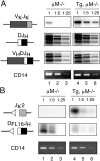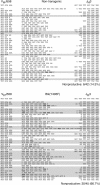Mimicry of pre-B cell receptor signaling by activation of the tyrosine kinase Blk
- PMID: 14662906
- PMCID: PMC2194155
- DOI: 10.1084/jem.20030729
Mimicry of pre-B cell receptor signaling by activation of the tyrosine kinase Blk
Abstract
During B lymphoid ontogeny, assembly of the pre-B cell receptor (BCR) is a principal developmental checkpoint at which several Src-related kinases may play redundant roles. Here the Src-related kinase Blk is shown to effect functions associated with the pre-BCR. B lymphoid expression of an active Blk mutant caused proliferation of B progenitor cells and enhanced responsiveness of these cells to interleukin 7. In mice lacking a functional pre-BCR, active Blk supported maturation beyond the pro-B cell stage, suppressed VH to DJH rearrangement, relieved selection for productive heavy chain rearrangement, and stimulated kappa rearrangement. These alterations were accompanied by tyrosine phosphorylation of immunoglobulin beta and Syk, as well as changes in gene expression consistent with developmental maturation. Thus, sustained activation of Blk induces responses normally associated with the pre-BCR.
Figures






References
-
- Gellert, M. 2002. V(D)J recombination: RAG proteins, repair factors and regulation. Annu. Rev. Biochem. 71:101–132. - PubMed
-
- Melchers, F., E. ten Boekel, T. Seidl, X.C. Kong, T. Yamagami, K. Onishi, T. Shimizu, A.G. Rolink, and J. Andersson. 2000. Repertoire selection by pre-B-cell receptors and B-cell receptors, and genetic control of B-cell development from immature to mature B cells. Immunol. Rev. 175:33–46. - PubMed
-
- Reth, M., and J. Wienands. 1997. Initiation and processing of signals from the B cell antigen receptor. Annu. Rev. Immunol. 15:453–479. - PubMed
-
- Stoddart, A., H.E. Fleming, and C.J. Paige. 2000. The role of the preBCR, the interleukin-7 receptor, and homotypic interactions during B-cell development. Immunol. Rev. 175:47–58. - PubMed
-
- Fleming, H.E., and C.J. Paige. 2001. Pre-B cell receptor signaling mediates selective response to IL-7 at the pro-B to pre-B cell transition via an ERK/MAP kinase-dependent pathway. Immunity. 15:521–531. - PubMed
Publication types
MeSH terms
Substances
Grants and funding
LinkOut - more resources
Full Text Sources
Molecular Biology Databases
Miscellaneous

